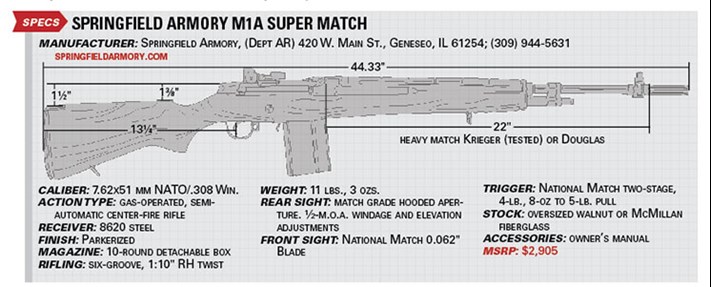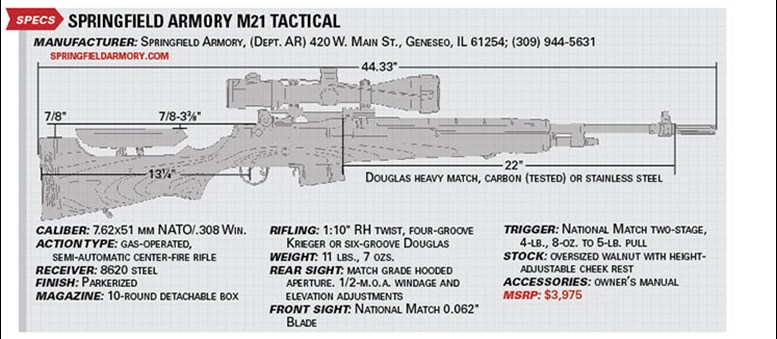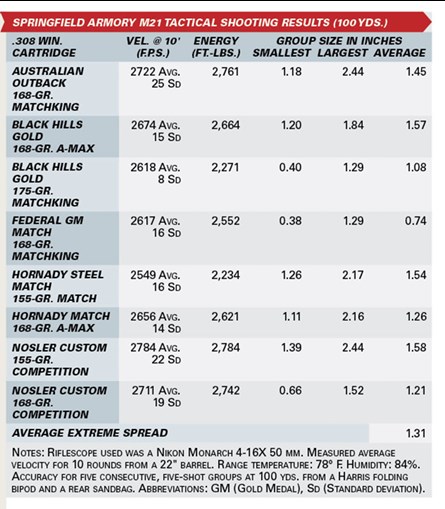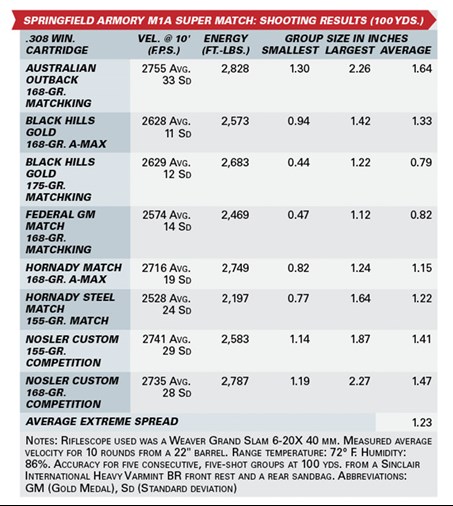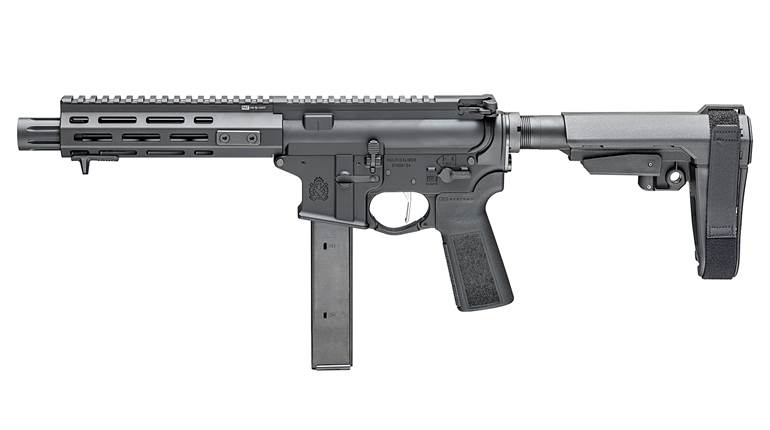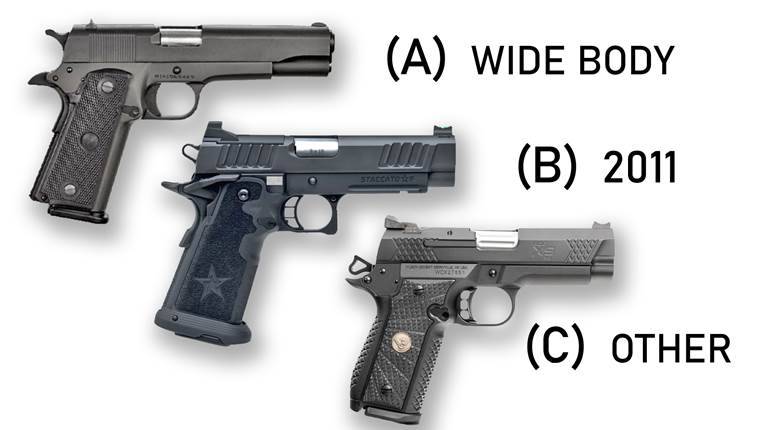Shooting the Springfield Armory M1A takes me back to a time when rifles designed for the U.S. military were made of walnut and steel. It was also a time when they were chambered for cartridges with an abundance of long-range authority, in this case the .308 Win/7.62x51 mm NATO. A powerful cartridge indeed, but the weight and gas operation of the M1A make it pleasant to shoot. No sissy bag needed at the bench—just snug the butt against your shoulder, take a good sight picture and press the trigger repeatedly until the ammunition is gone.
I am sure most who read this know that the M1A is a semi-automatic-only version of the M14, the latter designed to be fired in semi- or full-automatic modes. An improved version of the M1 Garand, the M14 was adopted in May of 1957 to replace the Garand, the M2 Carbine, the M3 “grease gun” and the Browning Automatic Rifle.
Due to the selective-fire capability of the M14, not many have made their way into civilian hands, but thanks to Springfield Armory, thousands of M1As have been enjoyed by recreational shooters around the world since its introduction in 1974. A number of variations are offered. The Standard M1A has a 22" carbon steel barrel and is offered with a walnut or synthetic stock, the latter in black, OD green or camouflage. Shorten the barrel to 18", replace the flash hider with a muzzle brake and add a barrel-mounted optic rail and you have the Scout Squad.
Moving up in price and accuracy, we have the Loaded version, also in walnut or synthetic. It has an air-gauged, National Match barrel of medium weight in stainless steel or chrome moly. The sights, trigger assembly and flash suppressor are also described as being of National Match quality. In the first case, that denotes a narrower front sight blade and smaller rear sight aperture. In the second, it indicates that the two-stage trigger has a pull weight of between 4 lbs., 8 ozs. and 5 lbs. In the third, it means that the flash hider has a larger-than-standard inner diameter so that even trapped droplets of rain water cannot contact the bullet as it leaves the gun. Such touches are all designed to elevate what was a rack-grade service rifle design to match or precision field standards.

The accuracy of a Loaded rifle I worked with ranged from 1.5 to 3.8 minute-of-angle (m.o.a.) with an overall average of 2.6 m.o.a. for five different factory match loads.
One of the most fun variations I have shot is the synthetic-stocked SOCOM II. Long Picatinny rails on the handguard allow easy attachment of accessories such as lights and lasers. It has a 16" barrel with muzzle brake and fully adjustable sights with a Tritium insert in the front post. Switch to a standard synthetic stock and handguard along with a barrel-mounted base for attaching a long-eye relief scope or electronic sight and you have the SOCOM 16.

Introduced in 1974, the National Match is still built in accordance with early recommendations from Army and Marine marksmanship unit armorers for service rifle matches. With the exception of its semi-automatic-only operation, it is basically a clone of the M14 National Match rifles built from 1962-1964 at the original Springfield Armory and by Thompson-Ramo-Wooldridge. The one from today’s Springfield Armory has the same match-grade, medium-heavy barrel as the Loaded rifle but certain other components such as the recoil spring guide, gas system assembly, sights (in this case, a hooded rear aperture) and flash suppressor are carefully selected and fitted by hand.
The Super Match, with its heavier barrel and 1-m.o.a accuracy guarantee, was introduced soon after the National Match. Hand-built in the match rifle shop, it has a rear-lugged receiver, a beefed-up operating rod guide and a glass-bedded walnut or McMillan composite stock with oversized dimensions at the grip and fore-end. I first shot a Super Match back in 1997, and five-shot averages with it ran from 1.22 to 2.81 m.o.a. with an overall average of 1.9 m.o.a. for five factory match loads. My best handload, CCI No. 34 primer, Federal case, Sierra 175-gr. MatchKing and 41.0 grs. of IMR-4895, averaged 0.87 m.o.a. More recently, another Super Match averaged 0.72" with that same load.
When I was shooting that first Super Match, a new version of the M1A called the M21 Tactical had just been introduced (even though M21 variants have been around since the 1980s) but I did not get around to shooting my first one until 2001. The outing was held at John Shaw’s Mid-South Institute in Mississippi and hosted by Dennis Reese and Rob Leatham of Springfield Armory. I recall Reese saying, “There is no way we can shoot up all that ammo.” We proved him wrong. Reactive steel targets were hammered out to 200 yds., but a dozen years would come and go before I had an opportunity to shoot groups on paper with an M21.
After breaking in the barrel with 75 rounds of Hornady’s Steel Match ammunition, I began squeezing off five-shot groups at 100 yds. with it and seven other factory loads. The barrel was allowed to cool down between each 25-round string. I was unable to squeeze 1-m.o.a. from the rifle with factory ammo, but the IMR-4895/Sierra 175-gr. MatchKing combo I had previously tried in two Super Match rifles consistently averaged slightly larger than 2" at 300 yds.
The M21 wears match-grade sights but the height-adjustable comb of its walnut stock, along with a receiver that accepts Springfield’s 4th generation mount, makes it too tempting to use with anything but a good scope. An adaptor made by MIM Manufacturing can be used for attaching a Harris folding bipod.
A second tactical rifle called the M25 was built in honor of legendary Marine Corps sniper Carlos Hathcock who became known as White Feather to his enemy combatants during the Vietnam War. With the exception of its synthetic stock, the rifle is quite similar to the M21. As approved by Hathcock’s estate, the rifle bears a stamping of his signature along with his trademark “White Feather” logo. Sadly, it is no longer in production, but rifles are still out there.
Standard-grade M1A rifles usually wear chrome-moly barrels, while Super Match rifles come with Krieger stainless or Douglas air-gauged chrome-moly barrels. Most have six-groove rifling with a right-hand twist at a rate of 1:11", but the Krieger on the M21 I tested is four-groove and 1:10". Standard trigger pull weight ranges from 5 to 6 lbs., match triggers are in the 4-lb., 8-oz. to 5-lb. range.
Overall rifle weights range from 9 lbs., 8 ozs. for standard models to 11-12 lbs. for heavy-barrel target versions. Steel and aluminum hardware in the adjustable comb of its oversized stock makes the M21 the heaviest at 13 lbs., 12 ozs. with a Weaver 6-20X Grand Slam scope, Springfield Armory mount, Warne rings and an empty magazine. The tactical rifle stock has a ventilated recoil pad while most of the others have a steel buttplate.
All M1As have fully adjustable sights with half-minute clicks on the match and tactical versions and one-minute adjustments on standard rifles. The aperture of the match-grade rear sight has a rotating hood with an indicator notch; twisting the hood to its notch-up position quick-shifts bullet point of impact up 1/2 m.o.a. Rotating the hood a half-turn to its notch-down position shifts impact down by the same amount.
One interesting feature of the rifle that is a holdover from its military service is the spindle valve located at the bottom rear of the gas cylinder. It controls gas flow through the cylinder’s interior and was originally included on the M14 design to prevent damage to the gun’s operating system when it was used to fire rifle grenades. On the M1A it offers the option of manual operation, effectively turning the M1A into a straight-pull bolt gun, and eliminating the ejection of fired cases into mud and dirt. With its slot positioned perpendicular to the barrel, gas flows from the barrel and into the gas cylinder to operate the action. Pushing in on the valve and turning its slot horizontal to the barrel shuts off gas flow. According to Springfield Armory, shutting off the gas in no way harms the rifle but it can affect accuracy. I have not found the latter to be entirely true, but it will occasionally cause sticky case extraction with some loads.
One final note: Like the M1 Garand, M14, M16 and some other rifles, the M1A has a free-floating firing pin. Allowing the bolt to fly forward without its velocity being reduced by stripping a cartridge from the magazine can cause a slam-fire. Should it occur prior to complete lockup of the bolt, serious damage to the rifle can occur with possible injury to the shooter. For this reason, the M1A owner’s manual stipulates that all cartridges are to be fed from the magazine. To further drive home the point, Springfield Armory includes with each rifle sold a reprint of an October 1983, American Rifleman article written by a competitor who experienced an out-of-battery slamfire with his M1 Garand.
Despite its age and the advances in AR-based .308 Win. service rifles, the M1A continues to enjoy its reputation as an icon of great reliability, competitive prowess and longevity. It is also one whose name is synonymous with an entire category of firearm—the semi-automatic version of the U.S. M14 service rifle.
Such attributes are likely to ensure that the M1A’s reputation will continue well into the future.
“Springfield” History
The original Springfield Armory was established by President George Washington in Springfield, Mass., and was responsible for the design, development and manufacture of arms for America’s military forces for close to 200 years. The Model 1795 Flintlock Musket was the first and many others followed such as the Model 1873 Trapdoor Springfield, the 1892 Krag, the 1903 Springfield, the M1 Garand and the M14.
The government-owned armory was closed in 1968, and in the early 1970s Elmer Ballance of Divine, Texas, had the Springfield Armory name trademarked. Convinced that a semi-automatic M14 would sell, he began making receivers by the investment casting process, completing them with military surplus parts.
When the BATF did not approve the name “M14,” it became M1A. Ballance later sold the company to the Reese family, who had long owned a successful machine shop, and it moved to Geneseo, Ill. Presently run by Dennis and Tom Reese, Springfield Armory has gained worldwide fame for its production of M1A rifles and M1911 pistols and the highly successful line of imported XD pistols.
—Layne Simpson
Springfield M1A Maintenance Tips
